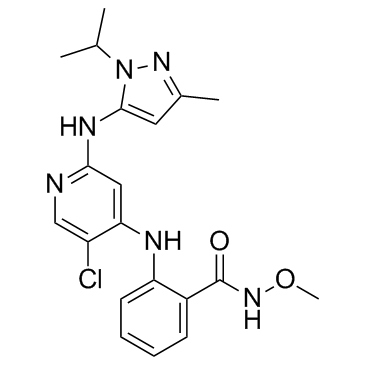1224887-10-8
| Name | GSK2256098 |
|---|---|
| Synonyms |
Benzenecarboximidic acid, 2-[[5-chloro-2-[[3-methyl-1-(1-methylethyl)-1H-pyrazol-5-yl]amino]-4-pyridinyl]amino]-N-methoxy-
2-({5-Chloro-2-[(1-isopropyl-3-methyl-1H-pyrazol-5-yl)amino]-4-pyridinyl}amino)-N-methoxybenzenecarboximidic acid GSK-2256098 |
| Description | GSK2256098 is a selective FAK kinase inhibitor, which inhibits growth and survival of pancreatic ductal adenocarcinoma cells. |
|---|---|
| Related Catalog | |
| Target |
FAK[1] |
| In Vitro | GSK2256098 is a thousand fold more selective for FAK compared to the nearest FAK family member, Pyk2. GSK2256098 inhibits FAK activity through targeting the phosphorylation site of FAK, tyrosine (Y) 397. GSK2256098 inhibits FAK activity or Y397 phosphorylation in cancer cell lines, OVCAR8 (ovary), U87MG (brain), and A549 (lung), at IC50s of 15, 8.5 and 12 nM, respectively. The responses of 6 PDAC cell lines in regards to FAK Y397 phosphorylation or activity to GSK2256098 treatments (0.1–10 μM) ranged from low (less than 20% inhibition) to high (more than 90% inhibition). The least and most sensitive cell lines (PANC-1 and L3.6P1) are selected for further analysis. GSK2256098 inhibition of FAK Y397 phosphorylation correlated with decreased levels of phosphorylated Akt and ERK in L3.6P1 cells. GSK2256098 decreases cell viability, anchorage-independent growth, and motility in a dose dependent manner[1]. |
| In Vivo | FAK is well-known to play an important role in angiogenesis, proliferation, and apoptosis, so the tumor samples harvested from the therapy experiments are examined. Evaluating CD31, significantly lower microvessel densities in tumors from mice treated with GSK2256098 and Paclitaxel is observed than in tumors from mice in the vehicle control group (P<0.05). This is consistent across both models, but Ishikawa tumors had the lowest microvessel density. All tumor models in mice treated with GSK2256098 exhibit less proliferation via Ki67 than control. Ishikawa tumors have the lowest Ki67 expression in response to therapy. Ishikawa tumors have higher apoptotic indices than Hec1A tumors after treatment with GSK2256098. Significant rates of apoptosis are seen in all models that had been treated with combination GSK2256098 and Paclitaxel[2]. |
| Cell Assay | PDAC cells are cultured on the wells of a 96-well plate. Ten microliters of MTS is added to the wells (total value: 100 μL). After the plate is kept in a 37°C incubator for 10-30 min, the absorbance at 450 nm wave length of reacted MTS is determined on a microplate reader. The Sigma plot program is used to calculate IC50 of GSK2256098 on cell viability. PDAC cells are cultured on a 6-well plate. When cell confluence reached about 70% in regular medium, the cells are incubated in the medium containing 0.1-10 μM GSK2256098 for 48 or 72 hr. At the end of treatments, cells are re-seeded and kept for 9 d Then, the cells are stained using Clonogenic Reagent, and the blue colonies are counted[1]. |
| Animal Admin | Mice[2] Female 8- to 12-week-old athymic nude mice are used. For therapeutic experiments, 4×106 Ishikawa or Hec1A cells are inoculated into the uterine horn. Following tumor cell injection, the mice are randomized (n=10 mice per group) according to the following groups: 1) 100 μL of a vehicle control (oral, daily); 2) 75 mg/kg GSK2256098 in 100 μL of vehicle (oral, daily); 3) 2.5 mg/kg Paclitaxel in 200 μL of PBS (intraperitoneal, weekly); and 4) GSK2256098 and Paclitaxel (doses and frequencies given above). Therapy is initiated 10-14 days after tumor injection. The mice are monitored for adverse effects and sacrificed using cervical dislocation four to six weeks after initiation of treatment. At the completion of each experiment, each mouse’s weight, aggregate tumor weight, location, and number of tumor nodules are recorded for each treatment group. Tumor samples are processed for further analysis via preservation in optimal cutting temperature medium for frozen section analysis as well as fixed in formalin for paraffin-embedded section analysis. |
| References |
| Density | 1.3±0.1 g/cm3 |
|---|---|
| Boiling Point | 545.7±60.0 °C at 760 mmHg |
| Molecular Formula | C20H23ClN6O2 |
| Molecular Weight | 414.889 |
| Flash Point | 283.8±32.9 °C |
| Exact Mass | 414.157104 |
| LogP | 7.34 |
| Vapour Pressure | 0.0±1.5 mmHg at 25°C |
| Index of Refraction | 1.638 |
| Storage condition | -20℃ |
